If you’re looking for advice, tips, and tricks from the greatest cinematographers then you’ve come to the right place. In this article, we will share over 150 of the best cinematography quotes from 40 master cinematographers.
Whether you’re a cinematographer, a photographer or you’re just interested in the filmmaking process, these brilliant cinematography quotes will help take your image creation and visual storytelling to the next level.
As far as we’re aware, this is the biggest list of cinematography quotes available on the internet. If you find it helpful then we would be grateful if you could share the article with others through your own blog, social media, or forums.
Related: Filmmaking Quotes from the Masters of Cinema
Recommended Site: filmmakingquotes.com
Cinematography Quotes
Forget the camera. The nature of the story determines the photographic style. Understand the story and make the most out of it. If the audience is conscious of tricks and effects, the cameraman’s genius, no matter how great it is, is wasted.
Gregg Toland
There are no rules and there is no formula to filling the frame to please everybody. I’ve got this corny saying though: ’There are three types of photography: good photography, bad photography and the right photography. The right photography is what tells the story best.’
Freddy Francis
I think the point of cinematography, of what we do, is intimacy. Is intent, is the balance between the familiar and the dream, it is being subjective and objective, it is being engaged and yet standing back and noticing something that perhaps other people didn’t notice before, or celebrating something that you feel is beautiful or valid, or true or engaging in some way.
Christopher Doyle
Sometimes I wish nobody would talk about how the movies are made. The idea would be that the audience goes to the theatre and they don’t even notice how it’s shot. I want the audience to just become immersed in the movie and feel the anxiety that the character goes through while his life implodes. That would be ideal.
Emmanuel Lubezki
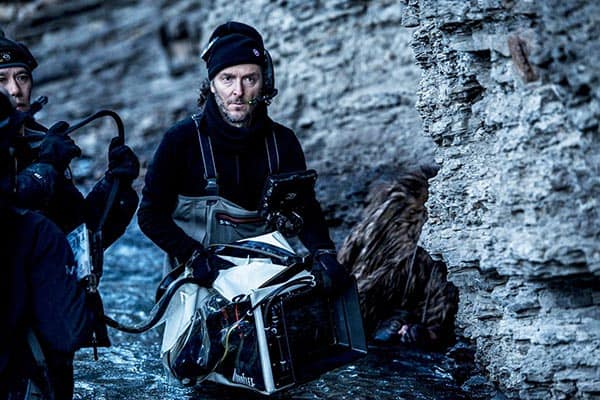
The Role of the Cinematographer
A cinematographer is a visual psychiatrist – moving an audience through a movie … making them think the way you want them to think, painting pictures in the dark.
Gordon Willis
The cinematographer is an executive of the production and has to run things for the director. You also have to read his mind and then get that up on the screen, because any good director has already shot the picture in his head and can see those images. They can be improved, but they are there.
Freddy Francis
A cinematographer has to design and write a story, starting at the beginning, through the evolution to the end. That’s why I consider my profession is as a writer of light.
Vittorio Storaro
The director of photography visualizes the picture purely from a photographic point of view, as determined by lights and the mood of the individual sequences and scenes. In other words, how to use angles, set-ups, lights, and camera as a means to tell the story.
John Alton
A cinematographers’ job is to light and make the actors and actresses look as good as possible. Directors are responsible for their performance. The cinema-tographer is responsible for their appearance on screen. Directors don’t want to know about performers looking good; they can’t be bothered with all that. All they are concerned with is their performance.
Oswald Morris
There’s always the intention to create visually stunning images, but ultimately, my greatest concern is to stay true to the drama of the scene.
Janusz Kamiński
Cameramen don’t necessarily determine the look of a picture, as much as the cameraman and director together. It’s a dialogue. For me, the most successful experiences are with a director who already has some vision.
John Bailey
The cameraman confers with the director on:
(a) the composition of shots for action, since some scenes require definite composition for their best dramatic effect, while others require the utmost fluidity, or freedom from any strict definition or stylization; (b) atmosphere; (c) the dramatic mood of the story, which they plan together from beginning to end; (d) the action of the piece.
Because of the mechanics of the camera and the optical illusions created by the lenses, the cameraman may suggest changes of action which will better attain the effect desired by the director.
Many times, a director is confronted with specific problems of accomplishing action. The cameraman may propose use of the camera unknown to the director which will achieve the same realism.
James Wong Howe
The films I’m happiest with are the films where everything comes together, starting with a good script, the right director, a good cast and a good art director. It’s the bringing together of a team of people to bring a wholeness and a unity to the subject. I think the cinematographer’s work is part of the whole.
Billy Williams
A cinematographer doesn’t actually operate the camera, he really directs how it operates and directs all the people that surround the camera. So really what they’re paying for is your ability to handle those people.
Bill Butler
The biggest challenge of any cinematographer is making the imagery fit together of a piece: that the whole film has a unity to it, and actually, that a shot doesn’t stand out.
Roger Deakins
My career is based primarily upon finding a balance with a director and their vision, and that means sublimating my own personal ego toward their material.
Robert Richardson
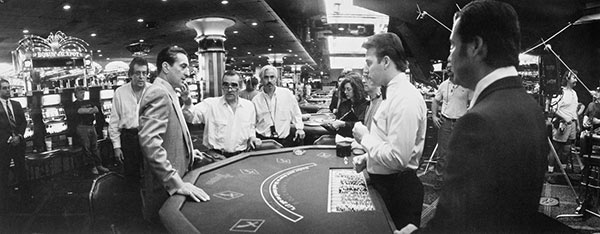
Finding Projects
My rule is that if a movie doesn’t say something of value for the audience, I don’t think it’s worth making. You only have time to make so many pictures in your life. Maybe 75 percent of the time, you can tell if a film will be worthwhile when you read the script, but I’ve been fooled on occasion.
There were times when I thought something was going to be a good movie, but it didn’t turn out that way. There are so many things that have to come together — the actors, the director, the script.
Vilmos Zsigmond
First of all, it’s the script. The more experience I get the more I see that a problematic or mediocre script in the hands of a brilliant director is still going to have problems. A brilliant script in the hands of an okay director can still be a very good film.
I’m coming to have more and more respect for what the script is and whether it can be successfully wrought or not. And if it isn’t, what are the chances it can be pulled together before you start shooting.
John Bailey
I’m very attracted to directors who want to experiment. The thing that attracts me the most are people who are trying find a language that is correct for their film, for that specific film.
Emmanuel Lubezki
When I read a script and like the story, I respond to it on an emotional level, I have a concept of who the characters are and where the story is taking us, and I then imagine how I can enhance the storytelling through visuals. The story automatically dictates how I’m going to light it.
That may sound simple, but it’s not, because it’s my personal interpretation of a script that allows me to create the visuals. That interpretation is based on my own life experiences, aesthetics, education, and knowledge, all of which help to shape my understanding of a story.
Janusz Kamiński
It has to come out of the material. Shakespeare said, “The play is the thing.” That’s still valid. If you don’t have a play, if you don’t have the dramatics, if you don’t have something to say about people, then what have you got?
Laszlo Kovacs
I won’t work with a director unless I feel that I’m on his wavelength. The three or four weeks I need in preparation for a picture mainly consists of just talking to the director so I can understand what he wants. Sometimes a director needs help. I’ve made wonderful films with directors who have never been in a film studio in their lives – they don’t have to know everything.
Freddy Francis
I don’t really know. It’s part of my whole person. Like you ask guys how they choose their girlfriends and they may say “I just like redheads” – but it’s very likely an oversimplification. So I think I choose what I do because of inner voices – I have a whole rationale to tell you about my conscious beliefs and my obvious political bent and so forth… but I don’t think that’s truly why I choose what I do.
Haskell Wexler
When I meet a director, I try to first talk about emotions and what the story means for the director. That’s why earlier I said that what I want from a director is passion; I want to do projects that are important to the director. Because then it’s personal and it matters.
Every decision about a movie, about cinematography, about light, about camera placement, is emotionally important. And after all, what matters in life, I think, is what you feel. So movies are represented emotions. I try to put those emotions into images. For me, that’s the main approach.
Rodrigo Prieto
It’s a combination of things. It does start with the script. If I really don’t like the subject matter of a script, then that’s it and I won’t do it. But if I like the script and I like the idea of working with a particular director, then I start considering what the visual potential of it is. So it is a combination of three things.
It has to be a story I want to do; a director whose work I like or who I would like to work with for the first time; and the visual potential of the picture. Also it has to do with whether I feel I can get some satisfaction out of doing that particular film. I don’t and I can’t do pictures that I really don’t care about. I can’t do a picture unless I really care.
Billy Williams
All the films I have photographed I was pretty excited about. There are a couple of exceptions: I did a couple of pictures where I was excited about the script but when I started to work on it I was not excited by the director. I want to have fun when I’m making a movie. It’s hard enough work to begin with, so if you don’t enjoy it, why are you shooting it? You want to have fun with and talk to the director and do things together.
Vilmos Zsigmond
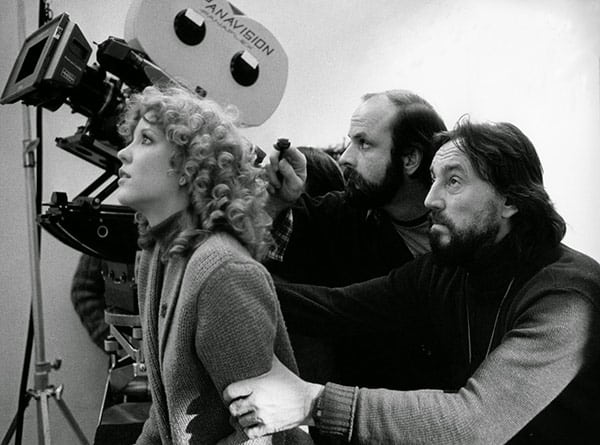
Preparation and Pre-Production
I think pre-production time is extremely important and I just don’t walk into a film two weeks before the start of shooting and have a couple of vague meetings with the director.
I like to see a lot of films with the director and talk about style, to go through the script sequence by sequence and, in the case of Schrader, shot by shot, essentially storyboarding what we want to do. It may change once we get on set and we see that the scene lays out quite differently.
John Bailey
I would say I spend most of my time getting into the head of the director – you know, having discussions, seeing locations, find out about the style of the film. I want to find out what he wants to do. Many times it’s difficult to find out because maybe the director himself doesn’t know exactly what he wants. But at least you can get as close to it as you can.
You want to get as much information as the director has in his head at that time. If you do that during the preparation stage than you’ve won half the game, because at least then you’re going to be in sync with them.
Vilmos Zsigmond
…You can sit down and discuss how to shoot a film with him [director] long before you start it. So when the heat of battle occurs, you don’t have to stop then to reload the riffle. You can take your shot and it’ll be right.
Bill Butler
When Ingmar and I made Winter Light, which takes place in a church on a winter day in Sweden, we decided we should not see any shadow in it at all because there would be no logical shadow in that setting.
We sat for weeks in a church in north Sweden, looking at the light during the three hours between 11 and two o’clock. We saw that it changed a lot, and it helped him in writing the script because he always writes the moods. I asked the production designer to build a ceiling in the church so I wouldn’t have any possibility of putting up lights or backlighting. I had to start with bounced light and then after that I think I made every picture with bounced light. I really feel ill when I see a direct light coming into faces with its big nose shadow.
Sven Nykvist
The ideal way to work is to decide with the director whether the scene plays in one cut or three or four. If you lay all that out before you even set a camera, then everybody knows what they’re doing and where they’re going next. And that includes the performers because they’re more comfortable with that too. There’s no confusion that way.
Gordon Willis
I really don’t believe that you can just photograph a movie; you have to decide what it’s supposed to look like before you can make a decision on how to light it.
Gordon Willis
I feel my job as a cinematographer is to get in the directors head and see the world through his or her eyes. I try and help him or her to create a vision and a way of seeing a story. I try to find out what drives a director to do a particular story – what’s the hook in the story?
Once I start to realize how they want to see it, I speak with them broadly, in non-technical terms about various aesthetic choices – light and dark, color and no color, whether the camera should be moving or not. I try to help draw the story out of them in visual terms. That’s the fun of it.
Frederick Elmes
The script is a blueprint, but the film is a process. I think that’s really important. Sometimes people are not quite prepared for that process, so sometimes you have to help them go there. Usually, once you start to see what you’re doing, hopefully you understand where you can go.
Which is the opposite to, “Okay, it was shit. Spider-Man is not going to work today. Let’s put $100,000,000 into making it look better.” I think we have absolutely opposite attitudes to what’s filmmaking. We make the film we can. They buy the film they think they want.
I’m not sure which one… of course, they have the box office, but I think we have the integrity. It’s a little bit different.
Christopher Doyle
I’m actually better as an improver; that’s what I am. I’m better at working out concepts with directors. With me, a director can feel very secure if he has an idea about a movie, because when he’s tired, I haven’t forgotten the idea. And when I’m tired, I expect the same thing from him.
Gordon Willis
Citizen Kane is by no means a conventional, run-of-the-mill movie. Its keynote is realism. As we worked together over the script and the final, pre-production planning, both Welles and I felt this, and felt that if it was possible the picture should be brought to the screen in such a way that the audience would feel it was looking at reality, rather than merely at a movie.
Gregg Toland
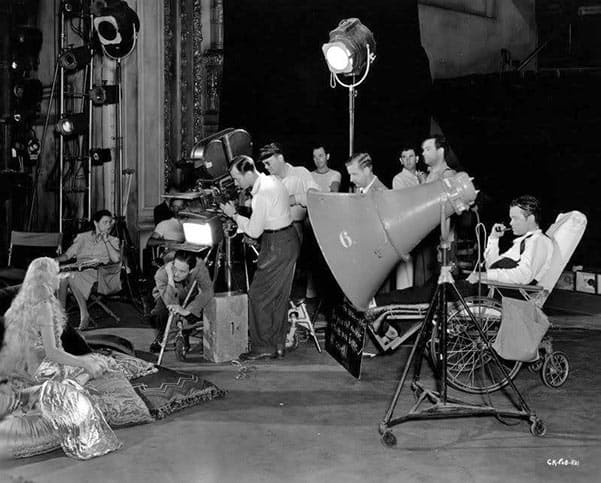
Visual Storytelling
My opinion of a well-photographed film is one where you look at it, and come out, and forget that you’ve looked at a moving picture. You forget that you’ve seen any photography. Then you’ve succeeded. If they all come out talking about “Oh, that beautiful scenic thing here,” I think you’ve killed the picture. A good picture, as we all know, starts with a story. The next thing is to tell that story pictorially. And the next thing is to put dialogue in it that doesn’t annoy people – just enough, and the way people talk. That’s my opinion of a moving picture.
Arthur Miller
Good storytelling. I always said that you could photograph a good story badly and it wouldn’t matter, but you can shoot a bad story well and it’s not going to help the story at all. It’s not. But you get the two together, and it’s great.
Gordon Willis
Pretty photography is easy: it’s really the easiest thing in the world. But photography that rounds a picture off, top to bottom, and holds the content together is really the most beautiful.
That means it can be visually very beautiful: it can also be pedestrian in certain ways because that is more appropriate to the story. You try not to put the photography in front of the story: you try and make it part of the story. It’s when you step outside of the picture that you’ve made a mistake.
Gordon Willis
You don’t always have to provide beautiful lighting, I often think ugly lighting and ugly composition tells the story much better than the perfect light. Sometimes a brightly front-lit image may be much more powerful than a silhouette. It all depends on the story.
You can’t really preconceive certain visual metaphors, because then the symbol really isn’t a symbol anymore – it’s more of a gimmick. What’s great about cinematography is that you work from your instincts and people later see your work and come up with [an analysis] that you didn’t even realize, but which may make perfect sense.
Janusz Kamiński
I believe that the best cameraman is one who recognizes the source, the story, as the basis of his work.
James Wong Howe
On commercials, you have thirty seconds to get the audience’s attention, so the visuals should be as powerful and memorable as possible. On a feature, you have to use photography to tell a story that’s going to last two hours.
If the visuals get too strong, you start to assault the senses of the audience, and it becomes very difficult for them to get into the story. So I think the photography of a feature should be restrained; its sole purpose should be to support the story.
Owen Roizman
Usually, if you notice good cinematography, then the cinematographer’s failing. I try to make light feel like it’s always motivated and natural in some way and hope that the lighting goes unnoticed.
Rachel Morrison
I love to work with symbolism, because it’s very strong visually.
Conrad Hall
Of course, the photography has to suit the individual picture you’re doing. If you had perfection in every shot, you’d lose the story, and besides, the photography wouldn’t mean anything – but if you had one or two great shots, say one at the beginning, a high point in the middle, and one at the end, those shots would stay in people’s minds. But the photography always has to be appropriate for the story. I’d sacrifice photography anytime for the sake of the story.
Lucian Ballad
You work in metaphors through light and composition, and the worst thing for me is to see a movie that doesn’t have that. You see a cinematographer’s work and there are no visual metaphors, or they are so afraid to create a style that it just becomes this nothing.
It’s a big palette, the movie screen. I dare to compare myself to painters, but I just have a bigger canvas to adapt to. If you don’t like my painting, don’t see the movie, you know?
Janusz Kamiński
Naturally, the cameraman studies the script. His main responsibility is to photograph the actors, action and background, by means of the moving camera, composition, and lighting – expressing the story in terms of the camera.
I believe in a minimum of camera movement and angles that do not violate sense but contribute intrinsically to the dramatic effect desired.
“Unseen” photography does not at all mean pedestrian photography; in its own terms it should express emotion, and that emotion, according to the story, may be light, somber, sinister, dramatic, tragic, quiet.
Within this frame there may be “terrific shots,” but there should be none outside it for mere effect. Photography must be integrated with the story.
James Wong Howe
Composition Quotes
If a shot lasts five seconds, the audience must see clearly in that five seconds what the picture is about. You have to see the actors right away, but at the same time you have to light the mood. Composition is really important in creating the mood: it also helps to sort out what you want the eye to see and in what order.
Vilmos Zsigmond
People confuse ‘pretty’ with good cinematography.
Roger Deakins
You see a lot of films where they’re so beautiful, but you really tend to forget what the story’s about. If you get totally captivated by an image, but you forget what the drama is within it then I think you’ve gone a step too far.
Dean Semler
The photography is a very large contribution. It just can’t look like a large contribution.
Gordon Willis
Images, not words, capture feelings in faces and atmosphere.
Sven Nykvist
The shot has to fit into the overall visual design of a film to have impact.
John Toll
The young filmmakers, God bless them, all want to do the greatest camera shot that’s ever been done, regardless of what it has to do with the picture.
William Fraker
First of all, the composition has to tell the story and create the mood. If there are a lot of elements in the composition besides the subject, you may need to lead the eye to the subject. You can do that with light. You can create certain selectivity within the composition with the lighting or as an element of the composition. A lot of composition is just plain feel – how you feel.
Jordan Cronenwerth
The most important thing is it [the composition] should be clear. In talking about composition you’re basically talking about long shots, I think. Of course, you have to compose close-ups also but that’s more like framing. Composition is very important when you have a big shot.
Film is a moving image and it has a certain time element to it. If the editor is cutting a long shot so that it lasts five seconds on the screen, that audience must clearly see, in that five seconds, what that picture is about.
Vilmos Zsigmond
Cinema is not an individual art. It takes many people to make a movie. There is a common intelligence. There is no doubt that the cinema is a language of images, and images are revealed and concealed by light and shadows. Cinema is never reality; as in painting or photography, you make decisions about what to show the audience with the use of space and movement and colors so you are superimposing your interpretation.
Vittorio Storaro
The edges of the frame are often more interesting than the center.
Luciano Tovoli
There is a kind of beauty in imperfection.
Conrad Hall
Nothing’s perfect… and it’s in the imperfection there is possibility.
Christopher Doyle
Contrast is what makes photography interesting.
Conrad Hall
It’s important not to confuse visual clichés with artistic photography. If a choice had to be made, I would much rather shoot a good picture than a good-looking picture.
Robert Richardson
There’s nothing worse than an ostentatious shot. Or some lighting that draws attention to itself, and you might go, ‘Oh, wow, that’s spectacular.’ Or that spectacular shot, a big crane move, or something.
Roger Deakins
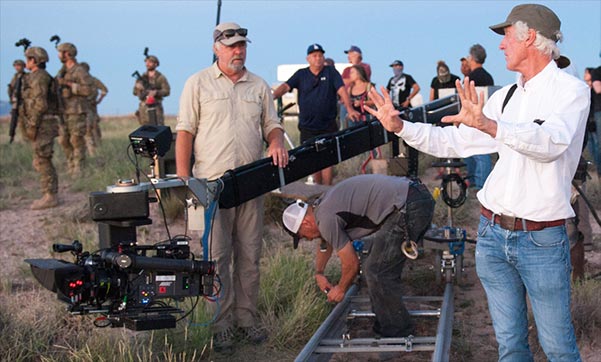
Cinematography and Use of Color
I knew in theory that you had to use backlight to separate [elements in the frame], and that you only had tones to work with. But I found that it was actually liberating to shoot black-and-white because it’s inherently more abstract than color. It’s one step removed from the reality of the red tie and the blue shirt. You start one step from reality, and from there, you can do pretty much whatever you want.
Michael Chapman
I often say half-jokingly, and it does surprise people, that I think color film doesn’t exist. They always say, ‘what do you mean, it doesn’t exist? We see films in color all the time.’ Yes, but my point of view is that as far as color is concerned, cinema is way behind painting.
One day there will be filmmakers who will have a real view of color; they will express themselves cinematographically through color, and not merely in color. This concept isn’t accepted yet. What I mean is that there must be creative artists, directors, who have the eye of a painter. Until then, color cinema does not really exist.
Henri Alekan
… I think it’s wrong to think that because you have a lot of paint you’re going to get a good painting. You can have a wonderful painting with just one color. I mean, children can show you that in a child’s drawing. They’ll stick to particular colors and it looks wonderful. Picasso loved to do that.
John Alonzo
You’ve got to remember when you’re working in color it’s a burden. You’ve got to worry about: Are the clothes all the right color? Are the walls all the right color Are the sets the color. How do they look together? So, emotionally, you have to deal with it. Black and white you don’t. You’re working in shades of gray, so it’s a different deal. But it can be beautiful shades of gray, like in “Manhattan,” or it can be an ugly film-noir kind of thing. It’s a very expressive form of filmmaking.
Gordon Willis
There is no doubt that every color is a specific wavelength of energy that can represent or symbolize a specific time of life. The meanings of colors are universal, even if they have different meanings in different cultures. Even if the audience doesn’t see the meanings of different colors, they can feel them.
Vittorio Storaro
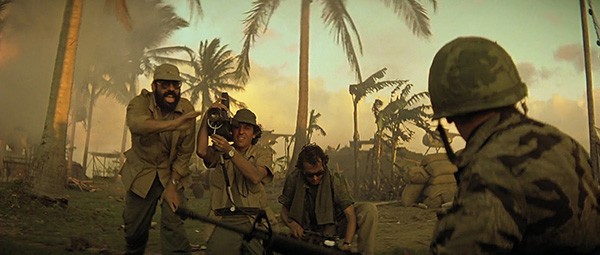
Camera Movement Quotes
My philosophy is, good camera movement happens when you’re not even aware of it. It just feels right. My approach has been to always let my instincts, the scene and what the actors are doing dictate whether or not the camera should move.
Owen Roizman
Camera movements are used to lead the eye, to give people a feeling – an emotional one, a logical one, a dramatic one – just the way lighting and framing are.
Haskell Wexler
Camera movement’s great, but it’s got to be about exposition. You have to involve the audience visually, but to do that, you don’t need fancy movement and 360-degree dolly shots.
William A. Fraker
I really think music and movement – dance, you know – and literature inform my visuals. I think film is also based in dance. The relationship between me, the camera and the actor is always a dance.
Christopher Doyle
My feeling is if you watch movies that were shot in the ’30s or ’40s a two-shot of people talking to each other will last for the entire scene. Maybe at the end they’ll put one button on it, or a close-up, of somebody saying, “I love you,” something like that.
There are a lot of people who shoot movies today who say, “Well, this is going to be boring. We’re not doing anything.” No, what’s boring is the content, what they’re saying. If that’s boring, you can move this camera up and down all day long, it’s not going to make the movie any better. It’s the content has to not be boring.
I don’t think a camera should be an imposition on a scene. [If] the actor starts walking and talking for a block and a half, your obligation is to stay with that, hold the atmosphere together. When the scene stops, you stop. And if it’s necessary to put a cut on the end of it or the beginning of it, fine. A moving camera doesn’t build pace into a movie. It’s what’s happening on the screen that builds pace. Also, it’s how you cut a movie together. I’m a great believer in cutting and a great believer in relativity, going from big to small, bright to dark.
Gordon Willis
[On Thin Red Line] A lot of what the characters go through emotionally is unspoken, so it was necessary to convey those moments in a visual way. We wanted the camera to tell the story and yet somehow be part of the story — almost as if the audience was making the same journey as the characters.
John Toll
On ‘Y Tu Mama Tambien,’ we started exploring shots that are longer, where the camera is moving around the actors, and there are no cuts, and you feel like you’re there. I was able to shoot a movie like ‘Tree of Life’ because I had done ‘Y Tu Mama Tambien.’ The camera needed to capture that sense of freedom and joy and life you have when you’re young.
Emmanuel Lubezki
For Citizen Kane, direct cuts would be avoided as often as possible. Instead, we tried to plan action so that the camera could pan or dolly from one angle to another whenever this type of treatment was desirable.
Greg Toland
When the camera begins to move, we are suddenly given the missing information as to shape and layout and size. The two-dimensional image acquires the illusion of three-dimensionality and we are carried across the divide of the screen, deeper and deeper into a world that is not contiguous to our own.
Garrett Brown
There’s a particular scene involving a confrontation between Mia Farrow and John Cassavetes. It’s a static shot all the way through, about two and a half or three minutes long. Then you push in to Mia, and she says, ‘Oh, my God. It’s alive, the baby’s alive.’ At that point, [director] Roman Polanski’s got the audience. It’s all about reserving the movement for the moment when you want to make a story point.
William Fraker
Somebody will say, ‘Let’s move the camera,’ [speaking of the type of director who came of age after 1980]. ‘Okay, why do you want to move it?’ ‘I don’t know, let’s just move it.’ Well, that doesn’t make sense to me. I usually like to hear a reason, or feel a reason.
Owen Roizman
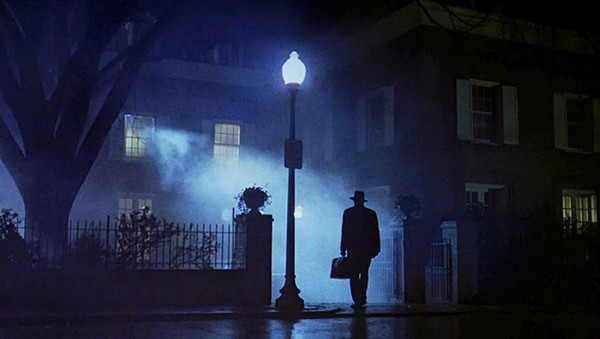
Lens Selection Cinematography Quotes
A good lens and a camera is all I need.
Sven Nykvist
I think the wide lenses allow you to make the movie very immersive and that was one of our main ideas: to engage the audience in a very immersive way. The movie wanted to be visceral, so it allows us to get very close to the actors but still see the environment surrounding them. They are always connected to the environment.
Emmanuel Lubezki
I love 10:1 zooms because I can find just the right angle I want, and I can even change that angle, especially while doing tracking shots. I never used a fixed lens for that because I wanted the flexibility to alter my angle to follow the performance or the composition. Of course, that meant having another assistant, but it worked for me!
Gilbert Taylor
Cinematography is more than a camera, whether that camera is a Red an Alexa or a Bolex. There is a little more to it that resolution, colour depth, latitude, grain structure, lens aberration etc. etc. etc. The lenses use for ‘Citizen Kane’ were in no way as good as a Primo or a Master Prime and the grain structure in that film is, frankly, all over the place. But the cinematography? Well, you tell me…
Roger Deakins
I like using prime lenses because it forces you to move the camera and think about where the camera needs to be.
Roger Deakins
The choice of lens is of incredible importance. Because, with a choice of lens, you can change reality, you can change perspective and even the relationship of people to each other. Your choice of lens has to relate very strongly to the dramatic content. It cannot be an arbitrary choice.
Laszlo Kovacs
I’ve used a Dior net stretched across the frame on just about every film I’ve shot in the last six or seven years. I find most lenses to be too sharp and contrasty, so I often use the stocking over the frame to soften the image a bit.
Janusz Kamiński
It’s important to remember that visual consistency is essential – you can’t suddenly start using very long lenses if you’ve been using wide lenses (unless, of course, you want the jarring effect this creates). At the same time it can become monotonous if you don’t occasionally temper that consistency.
Janusz Kamiński
Zooms are unbelievably handy. You might have Nick Nolte screaming down the lens and forgetting where the hell he is, what country he’s in, let alone what mark he’s supposed to be on. So to give yourself the latitude there, the director will be grateful forever if you manage to get that performance.
If you don’t get it because you were frightened to do something… If you do it again, you might never get that same performance.
Dean Semler
[Gilbert Taylor] mostly used reflected light bounced off the ceiling or walls, and never consulted a light meter. As the rushes were shown, however, he possessed such an unerring eye that his exposures were invariably perfect. We differed on only one point: Gil disliked a wide-angle lens for close-ups of Catherine, a device I needed in order to convey Carol’s mental disintegration. ‘I hate doing this to a beautiful woman,’ he used to mutter.
Roman Polanski
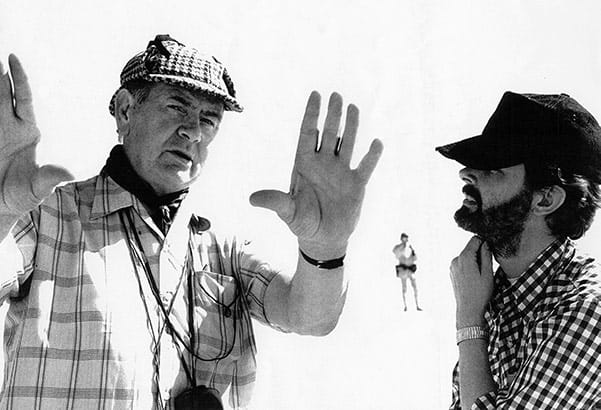
Cinematography Lighting Quotes
Lighting strives to bring out the following values:
1. Orientation – to enable the audience to see where the story is taking place.
John Alton
2. Mood or feeling (season of year and time of day).
3. Pictorial beauty, aesthetic pleasure.
4. Depth, perspective, third dimensional illusion.
I think the most important thing about cinematography is lighting. That’s how you create the mood that matches the story. The ability to light artistically is a gift from the gods. If you have the ability, you shouldn’t waste it. You should be looking for ways to improve and grow.
Vilmos Zsigmond
If someone says to me, ‘I loved that shot, how did you light it?’, I’ll think they’ve lost the point. My explanation doesn’t mean a thing because there are 20 ways to light a shot and get the same result. Why you do something is far more important than how.
Freddie Francis
There are infinite shadings of light and shadows and colors… it’s an extraordinarily subtle language. Figuring out how to speak that language is a lifetime job.
Conrad Hall
Manipulating shadows and tonality is like writing music or a poem.
Conrad Hall
Lighting is so complex that it’s hard to quantify. It’s like playing piano. How did I do that? What did my fingers do? What made me think about where they should go?
I like to equate cinema to music. I’m performing a musical composition when lighting a scene. There are crescendos, allegros and pizzicatos. The visual language is an undulating language, and, like music, it has to have its peaks and valleys.
You can’t just photograph everything beautifully; otherwise. how would you get the gasps if you had nothing but gasps?
You can only get a gasp because the audience hasn’t been paying attention to anything but the story and the actors. Then suddenly, there’s something magical that grabs them. Those instances do something to the story and the individual watching, and it’s those rythms [in the visual construction] that are important.
Conrad Hall
I think the audience doesn’t know a movie’s lit, but they feel it. Because you’ve walked in a forest many times, or in a park, so you know how it looks. When you start lighting, subconsciously you know there is something that is absolutely wrong.
Emmanuel Lubezki
Other cameramen illuminated for exposure. They’d put a lot of light in it so the audience could see everything. I used light for mood. All my pictures looked different. That’s what made my name, that’s what set me apart. People asked for me. I gambled. In most cases, the studios objected. They had the idea that the audience should be able to see everything. But when I started making dark pictures, the audience saw there was a purpose to it.
John Alton
I think lighting is the only metaphor that works in film. We light the set in a way that supposedly is a correlative for a state of a character, or the nature of the scene, or the mood. It’s hopefully more than just the mood of what appears in the theatre, but it becomes a dialectic. There’s a sense in movies that things are not standing still the way they are in the theatre.
We are recreating a realistic space and trying to make something optically real even if it’s not naturalistic. We’re trying to create the illusion that time is advancing: it’s early morning, late afternoon, midnight. This infuses the story with some kind of meaning. I have a secret power that I can change the nature of this film by how I light it.
Robert Elswit
I’m learning more and more about lighting… But you have to be encouraged by the directors. They allow you make the choices that take the movies to a different level.
Directors can allow cinematographers to advance to another level, because we all have that capability in us. Some are so scared of taking risks that they won’t allow their cinematographers to try something new. But you can create such powerful and meaningful images by taking chances…
We’ve all got the ability to do groundbreaking work, and nothing is stopping us from using very experimental techniques in a major Hollywood movie if the subject matter allows it and the director is willing to go there.
Janusz Kamiński
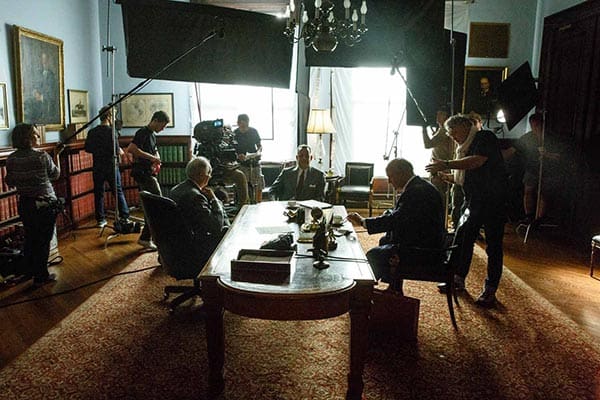
The Lighting Process
I start with realism. My way of lighting and seeing is realistic. I don’t use imagination, I use research. I go to a location and see where the light falls normally and I just try and catch it as it is to reinforce it if it is insufficient; that’s on a natural set.
On an artificial set, I suppose that there is a sun outside the house and then I see how the light would come through the window and I reconstruct it. The source of light should always be justified. And when it’s night, my light simply comes from lampshades or any natural source light you can see in the frame.
That is my method. I haven’t invented that of course.
Nestor Almendros
For a cameraman, most of the time is lost in lighting. Well, very often I go to a place an I realize that is very nicely lit as it is. So what we do is choreograph the actors in relationship to the existing situation and it’s easier that way. I think that spending too much time in lighting, you end up being a mannerist. And that’s something I learned from a short experience I had with Roger Corman.
Nestor Almendros
I go back and forth about how I light scenes and what sort of units I use.
Sometimes I bounce light, and sometimes I project it through diffusion. Of course, it also depends on the film in question and the style of that film, as well as the practicality of a given technique for a certain location.
When you’re in a restricting location, you often end up bouncing light because you don’t have the space to project it through frames of diffusion.
Roger Deakins
In general, I like to make a light source look as if it’s really working, instead of overpowering it with an artificial source. I do use gag lights, but I like the sources themselves to be very bright within the scene.
Roger Deakins
Jimmy Wong Howe once told me: Start with the source as the premise, but if the source as the premise does not work and does not look right, then change the source, just make up a source.
And that is the best way because in the end result, you do not know how they are going to cut the picture. No director will start with the shot of a window and say, “Here is the light coming from this direction, “ and then cut to the actor. You may never see the window in the entire scene.
It is the overall character of the light direction that matters. The exact angle of light will never be scrutinized by the audience as long as it is not disorientating.
John Alonzo
If you look at my work, you’ll see that I almost always worked a little above the average key light because the use of bounced light served to fill the shadows a bit, just enough so that I could take my key up past the middle on the printer scale – if center was a 12, then I was at about a 14. That gave the image extra guts, so I was always generous with my exposures to get that extra contrast. I’d just blast everything with light.
Gilbert Taylor
It’s amazing to me how often I hear cinematographers say that they think shooting good-looking day exterior movies is all about sitting around and waiting for the right light to happen, and then just pointing your camera at it and shooting ‘pretty pictures.’
Doing good work in day exterior situations means that you must be able to make great images all day long, even when the light isn’t ideal for pretty pictures. You must make choices that will allow you to take advantage of natural light in existing conditions. Even when the light is ‘bad’ it is possible to do good work by making wise choices.
John Toll
The first thing I ask myself when I walk into a place of that kind, or of any kind, is: “What does it look like with the lights on that are there?”
Gordon Willis
During the actual production, I started out with a relatively simple form of overhead lighting, using a batten containing some nook lights that were bounced into these hanging skirts of bleached muslin. I later designed more sophisticated units that we also used on the subsequent Godfather films.
Gordon Willis
I establish a source. The position of light can change in various setups but the general character of the source will still look the same on the screen. You just need to enhance the source. Now, whether it needs more light or stronger light, it will still be the same in character.
Richard Kline
The approach we took [for the Exorcist] was ‘let’s not make it look like a horror picture, let’s try and make it look believable.’ The lighting I used was very realistic; I didn’t get fancy with it at all. Occasionally I enhanced something to make it look a little bit more dramatic, but I basically tried to stay true to the light sources and moods. The best way you could describe my style is that I like to create the proper mood to fit the story.
Owen Roizman
You create your own sources. When I walk onto any set, the main thing I discuss with the art director is where are the light sources. When an art director works with me, they know this so they do it without being asked. Without light sources of course, there is no lighting. And that’s boring.
There is nothing more boring to me than fluorescent overhead lighting in a supermarket, for example. So many times, I alter that reality. I’m usually using that overhead lighting but I will introduce some soft, side light which does not exist in a market. But nobody will question that because it’s soft. It will look real but interesting. It gives you more modeling, it gives you a better look.
Vilmos Zsigmond
Caravaggio was a great teacher for me. He painted by making a tiny hole in black paper over a window. He was working with a small and therefore very directional light source. I have often used this approach: a very directional primary light source, accompanied by secondary sources that are the offshoots from the primary, as well as reflections of the primary on surfaces, like walls.
Henri Alekan
It comes from painting. A single source light: the moon, the sun, a candle. Those are the three basic sources of light in our life. Now you can say, at night-time, it’s a shop window or a street light, or if you’re in the countryside it’s the moon. If there’s no moon, what do you do, you recreate something to suggest it’s the moon. Maybe through a lack of imagination or thinking, if there was no artificial light, what would it be. And that’s the departure point for what I do.
On Harry Potter, we were shooting in a hall, which was, I don’t know, 150 meters long by 80 meters wide. The principles of lighting remain the same: the small room has one source of light, a big window. If you want a big hall to have the same type of light, you add windows every ten meters to bring light through.
Michael Seresin
People ask, ‘What’s the mood of the picture?’ but I ask, ‘What’s the mood of the scene?’ I felt each scene deserved some thought as to its mood. I can’t think of a picture where I tried to light it exactly the same all the way through to keep the same mood, because I just didn’t feel it would work that way.
When I first became a cameraman, I was told that comedy should be bright, but after a couple of shows I threw that out the window because I didn’t believe it anymore. I think there’s a chance to do interesting things whether the picture is a comedy or a drama. I liked to play each scene for what it was.
Fred Koenekamp
I’ve always loved shooting at practical locations, You can’t move the walls, and the light comes from directions where there are windows and lamps. But light doesn’t always have to be motivated. It can be totally unrealistic and stylized if it fits the story.
You can analyze it, but it also has to feel right. The big question is whether you have the guts and heart to trust your intuition.
Janusz Kamiński
To give a more realistic feel on stages, I usually tend to work a bit sloppier. When there is a practical or window I want them to burn out. It gives the impression that we don’t have total control. If we did everything would be perfect and balanced.
Janusz Kamiński
I like to have a strong sense of light in a scene; I hate it when things are flatly lit. I’m the kind of Cinematographer who lights in such a way that when you walk on the set, you always know what the source of the light is.
Janusz Kamiński
We had it built onstage, of course, and lit primarily through the windows – Brutes, often fully spotted, just blasting in. A few hidden lamps on the floor bouncing into the ceiling completed the lighting. It was very extreme.
I shot much of the film [Repulsion] with a handheld Arriflex with a very wide lens and a tiny tobacco tin on the front fitted with a wee bulb to add a bit of fill, just enough to see Catherine Deneuve’s skin in the shadows until I moved in close.
Gilbert Taylor
I love backlight not just for the sake of glamorizing [the subject], but because the direction of the light can represent storytelling, I don’t do backlights and then also add key lights and all these things. If I do backlight, I want to see that backlight. That’s my style, and that’s the way we’ve done it in every single movie. You get criticism for that kind of lighting and you get prizes for that kind of lighting.
Janusz Kamiński
I love the idea that all the light is generated by a source within the film because it always plays a part in the story you are telling, The light itself is alive. It’s coming from someone and I think that a light that is coming from nowhere is a very scary thing, it needs to be kept to science fiction films or for a specific conceptual light for a story.
Darius Khondji
At night when we look into an illuminated room from the dark outside, we can see inside but cannot be seen ourselves. A similar situation exists in the motion picture theatre during a performance. We sit in the dark looking at a light screen; this gives a definite feeling of depth.
In order to continue this depth on the screen, the progression from dark to light must be followed up. The spot which should appear to be the most distant should be the lightest, and vice versa…
John Alton
I wanted to light the hotel so that it looked weird and mysterious, but, at the same time, wasn’t lit by an unknown source. So I imagined that the hotel would have floodlights on it, as most hotels do, especially at skiing resorts – at the same time lighting it up, but not making it look too pretty.
Then I also used smoke for the night exteriors, which again gave it a more mysterious look and softened the lights so that they weren’t so contrasty.
The result was a kind of glow that was in keeping with the film itself, and especially the attitude of the hotel, as well. Although I used smoke, the intention was not to produce the effect of fog, but of cloud.
John Alcott
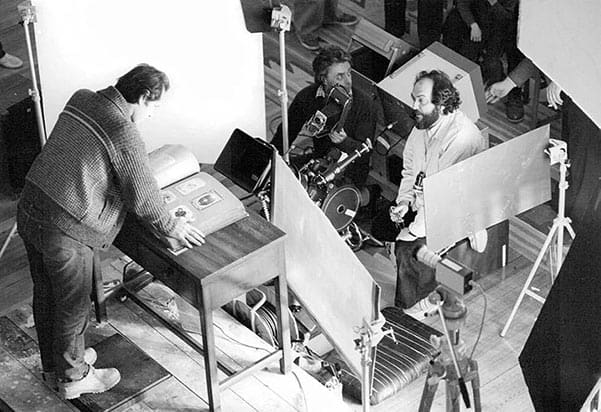
Darkness
It’s not what you light – it’s what you DON’T light.
John Alton
There’s nothing that can ruin an atmosphere so easily as too much light.
Sven Nykvist
By not explaining everything with light, darkness gives my imagination an opening. Therefore, I sometimes choose to hold back light in areas of the frame, because I don’t want to explain the image that clearly. I want to make the audience imagine, and fish for what’s out there. It allows the audience to bring a little bit of themselves into the story.
Fred Elmes
Everything that is shadow, penumbra, and darkness suggests a dramatization of the subject. I need no further proof of this than the immense work of great painters like Rembrandt, who worked so much in shadows.
Henri Alekan
I had a philosophy, which I used more in Godfather II than in the first one, that I didn’t give a shit whether I saw their eyes or not. It seemed more appropriate not to see their eyes because of what was going on in their heads at certain moments.
I had a lot of trouble with that from traditionalists. I said: “That’s the way it is because I think it is appropriate at this moment. In another scene, you will see their eyes because it is appropriate to that moment..”
Gordon Willis
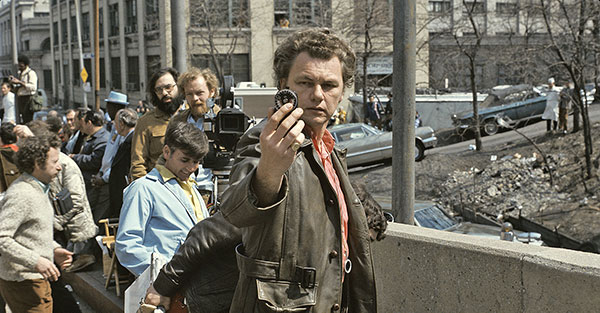
Natural Light and Simplicity
I’ve always been a natural light source type of cameraman – if one can put it that way. I think it’s exciting, actually, to see what illumination is provided by daylight and then try to create the effect.
John Alcott
When you put someone in front of a window, you’re getting the reflection from the blue sky and the clouds and the sun bouncing on the grass and in the room. You’re getting all these colors and a different quality of light. It’s very hard to go back to artificial light in the same movie. It’s like you’re setting a tone, and artificial light feels weird and awkward [after that].
Emmanuel Lubezki
Earlier, I made a lot of what I thought were beautiful shots with much backlighting and many effects, absolutely none of which were motivated by anything in the film at all. As soon as we had a painting on the wall, we thought it should have a glow around it. It was terrible and I can hardly stand to see my own films on television anymore. I look for two minutes and then I thank God that there is a word called simplicity.
Sven Nykvist
I like simplicity. I like using natural sources. I like images to look natural – as though somebody sitting in a room by a lamp is being lit by that lamp.
Roger Deakins
It is much easier to lead the audience to what you want to see [in B&W]. You either light the face, or you light the background. The eye naturally goes to the brightest object in the scene, rather then to something with bright colour. So it helps us to focus the audience more clearly on the story.
Janusz Kamiński
Lessons from the Set
I spent a lot of time on films taking things out. Art directors would get very cross with me. If something’s not going well, my impulse is to minimalize. The impulse of most people when something’s not going well is to add — too many colors, too many items on a screen, too many lights. If you’re not careful, you’re lighting the lighting.
Gordon Willis
I have the assistant keep a shot-to-shot log book which gives the f-stop, the filtration, whether there were any nets, the focial length of the lens etc.
A lot of times you can’t complete a sequence on a given day. Maybe you have to come back and finish it three weeks later but you want everything to match. The only way to really remember that clearly is to keep a log book.
Also you may have shot and wrapped the picture and then three months later the director decides he wants to pick up some extra shots or an additional sequence. If you don’t have the notes, then it’s very hard to match.
John Bailey
Much of what we did on Dead Men was archaeology; we dug out old arc lights and had them cleaned up and polished. Don [Scott] showed me techniques I didn’t know how to do, things that involved mirrors and pans of water, that they once did routinely. I don’t think anybody remembers how to do them anymore.
Michael Chapman
I’m not a great believer that you have to see an actor all the time on the screen. I believe that the scene has to be played properly, but sometimes it’s better not to see what is going on until a given point in the scene. Then you see something.
Gordon Willis
The day to day business of making movies is a matter of problem solving. You are constantly problem solving from the time you arrive on the set until you quit shooting in the evenings.
Bill Butler
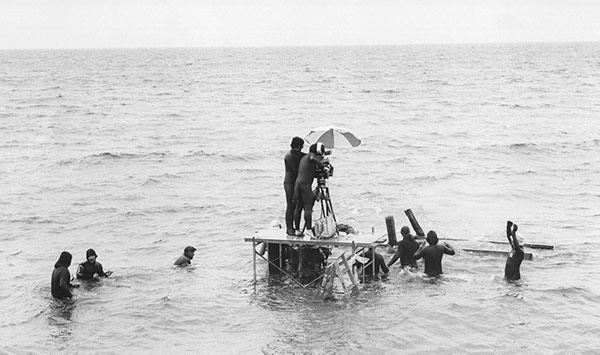
Any work the cameraman can do with an art director is money in the bank, because basically an art director is giving you what to photograph. You will be asking for practicals, you two will be deciding where the windows are, whether certain walls are wild, whether ceilings are wild, how high the walls are, and what color they are painted.
Haskell Wexler
American films are overlit compared to European ones. I like close-ups shadowy, in profile – which they never do these days… What’s needed is simple symmetry, but everyone wants massive coverage these days because they don’t have enough confidence in their work and there are way too many cooks in the kitchen.
Gordon Willis
You can do the best photography in the world but if the actors are lousy, it will still be a lousy movie no matter how gorgeous it looks. And what good is that? To be good, a movie has to be well crafted on all levels.
Vilmos Zsigmond
One of the main differences was that Terry didn’t want me to read the script. He wanted me to approach the movies in a completely fresh way, and arrive to the sets and try to figure it out as I’m shooting. In that way the camera would be accidental, and unrehearsed, more like a memory.
What I did feel going from LA to Austin was that I felt excited to go to work the next day. It was incredibly exciting to not know what we were going to do, but knowing that we wanted to find something great. I didn’t know who the characters were and how they were related.
You start shooting though, and you start to understand their connections and the arcs of their stories. It was almost like watching the movie as you were shooting it.
Emmanuel Lubezki
American Directors shoot too much I think. It takes more time for the editing: you have too many choices, too many angles. With many American films, you feel they are cutting for no reason: its just because they have another shot of it.
The films tend to look alike because they all go through the same method of shooting – it comes out as if it were made by computers. A computer could actually make a movie: it could see how many camera positions you can have for a scene – ask the computer and it will tell you…
It just becomes a mechanism and has no personality. I believe in limitations and discipline.
Nestor Almendros
I saw one [a movie] the other night, The Out of Towners. This is my idea of entertainment. Fast-moving, pictorial, not overloaded with dialogue. You could see that picture without dialogue and you’d know what it was all about. This was the secret of John Ford’s pictures. You could run any of his pictures silent, and you’d still know what they were all about. Most pictures you can’t. So the whole secret is, to get down to one word, realism. Realism at its prettiest: a girl looking her best – not overdone, just looking her best, without makeup, looking that way. Then you’ve got photography.
Arthur Mller
I photographed fifty-eight feature films. The first third of those was a struggle because every film is different. I have got to cope with style, exterior, and interior problems. In those days we were switching from black and white to colour, so the first third were a sweat. Things settled down in the middle third because I knew the basic things about lighting. But you have got to do more than that eventually. It’s like advancing toward the enemy, then digging in before the next advance. The last third were the best. By then I felt free to do anything I wanted. I experimented and took chances. That is when it became very exciting.
Oswald Morris
At the end of my career, I have learned to simplify. I take montage more into account.
When I did Beauty and the Beast, I attached significant importance to the scenes which ultimately could have been simplified, because they would only last a few seconds after the editing. I told myself that the sensitivity of people is such that they will perceive each nuance that I wanted to add with the weight of lights and shadows.
At the beginning of my career, it seemed to me that everything was so important that I had to build the light with great application, as if it was a succession of paintings that one was going to examine. It wasn’t true though; the camera would fly by and I would spend three hours doing something that no one would have the time to perceive.
Henri Alekan
We realized that because you are faster, you are not necessarily worse in cinema; and because you take a long time to prepare something, it is not necessarily going to be better.
With every shot you take time somehow; some shots you take longer that with others. But, on the whole, you just have to go ahead and shoot and follow your intuition, Sometimes if you think too much you sort of lose the intuition and natural flow.
Nestor Almendros
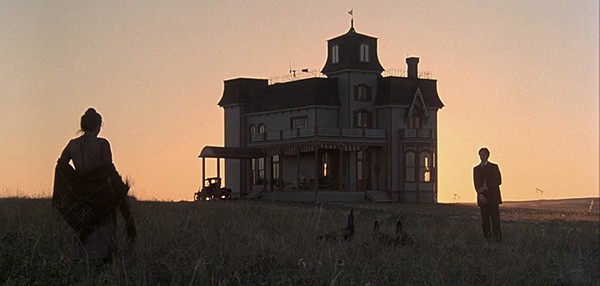
Cinematography and Style Quotes
I’m sure I adapted [my technique] to what was good for comedy, but by and large, I don’t think you have to elaborately change your way of doing things.
They always say tragedy is a close-up and comedy is a long shot, and I think that’s true. You want the joker and the jokee to be in the frame at the same time. On comedies, I use a little more fill light; you tend to create a lit atmosphere where the performers can be at home, where they can move around and do their jokes without having to hit a precise mark.
Michael Chapman
If somebody says, “What style are you going to shoot this movie in?” my answer is, “The only style I have is the style that suits the script.” You keep a concept of what the basic script is all about. Comedy might be a bit brighter than a heavy drama, but I see many scenes in heavy drama where you want a visual relief.
Don McAlpine
Study every kind of film and art, and shoot your own video/film with your fellow students and contemporaries. That’s what I did when I was at film school and the mistakes I made and the lessons I learned then, I have never forgotten. I don’t believe that any one person can teach you how to shoot, but experience can.
Stephen Goldblatt
Style starts to emerge when reading the script. I always read the script three or four or five times. Generally, along the way, I discuss it with the director, and then start to come up with an overall visual concept that I seek for the film. It does not mean that this concept is ironclad. I think, the cameraman comes up with his way of seeing a movie. Then hopefully you are in sync with the director.
It is important to develop an idea about the story early enough, so at least you will find out whether you think the same way as the director. Otherwise you get yourself in a situation where you are at odds with each other the whole time.
Caleb Deschanel
Style really comes from taste. If you try something and you don’t like it, you had better abandon it because otherwise you’re going to find yourself in a rut you’ll never get out of. If you like it, then you have to perfect it and make it work for you. You also have to be able to vary it and apply it to the material at hand.
Owen Roizman
They taught us that a movie is only art if it has something important to say. It should be more than entertainment. It should have social value.
Vilmos Zsigmond
Style is not the goal for a cinematographer; the director is the one who should have a style. If I do have a style then it is the end result of everything I’ve mentioned, and not a starting place.
It’s true that you meet with the director and he tells you what the film means, and what he wants to see on screen. And you do think about and you do try and find the appropriate lighting. At the same time, when you find yourself on set, you have to do what you feel, because that’s the only thing you know how to do.
Phillipe Rousselot
Reality in movies is the reality of the story you’re telling, so it may not match the reality as we know it, but the reason there’s art is that it tries to bring some kind of understanding of all the suffering and joys and pain that we go through. Storytelling brings some value to it.
Caleb Deschanel
I’ve always thought the camera’s placement, movement and framing are the most important aspects of cinematography, but I tend to make those decisions instinctively rather than intellectually. If I have an idea for a shot or blocking, it’s usually something that just feels right to me; it’s not something I can necessarily intellectualize.
Roger Deakins
It would be wrong to take a painter and ask him to paint in a certain style from the past. It would be wrong to ask a Cinematographer to photograph a film in the same style as another picture because you can never do that. The same elements, the same history does not exist in the same way as it did previously. But you can reference past work in order to be more clear with yourself about where you want to go and what you want to do.
Vittorio Storaro
So much contemporary film and television is involved with getting people’s attention. The fascination with the details in the technology and tools has prevented many contemporary filmmakers from exploring better ways to impart visual drama.
Haskell Wexler
Movies are a craft, they’re not art. The art comes out of the craft. For example, you may have a great idea for a painting, but can you paint? If you say “no” then your idea s worthless because there’s no way for you to project that idea. It’s being able to execute the idea that sets you free.
Gordon Willis
I’m totally sure that the way in which the films are made – my own films and the films of Wong Kar-wai – are totally informed by literature, not by film. It’s not what they teach you in USC. It’s not three-part structure-never. Sometimes it works; sometimes it doesn’t work. But I think the films we make are jazz. The films we make are literary because it’s an engagement with how narrative can work.
Good guy, conflict, now they’re friends – which is 90% of American films. It’s the same shit. So aren’t we trying to create another experience or another ambiance or another engagement with the audience? Literature is, to me, music. Literature and music are basic sources. They give us this place to have an investment. You interpret as you wish. Music doesn’t explain itself; why should a film explain itself?
Christopher Doyle
Advice for Cinematographers
If I were young, I would spend a lot of my time learning the digital end of post-production. Why not? I’d love to get in there and paint; I’d love to make a movie that looks like Monet or Picasso. If you can get to the edge of abstraction, why not try it? It could be wonderful.
Michael Chapman
The advice I got the first day I worked in the film business: Always be five minutes early to work, never five minutes late. But more importantly, live on the edge when it comes to your photography – take risks. Put your ideas on film and fall down a few times; it will make you a great filmmaker.
Salvatore Totino
I encourage film students who are interested in cinematography to study sculpture, paintings, music, writing and other arts. Filmmaking consists of all the arts combined.
Students are always asking me for advice, and I tell them that they have to be enthusiastic, because it’s hard work. The only way to enjoy it is to be totally immersed. If you don’t get involved on that level, it could be a very miserable job. I only have one regret about my career: I’m sorry that we are not making silent movies any more. That is the purest art form I can imagine.
Vilmos Zsigmond
Learn the rules before you try to bend or break them. You need a foundation on which to build.
Douglas Slocombe
We can never go backwards. We should always move forward and look for ways to improve the art of making movies. I think of my career as a continuous search for balance and harmony between the opposing elemental forces of life: light and shadows, conscious and unconscious, matter and energy, men and women. Filmmaking is a lifelong journey.
Vittorio Storaro
The cinematographer is a storyteller, and his main job is to communicate with the director and get his ideas on the screen. I just always insist on having a wonderful operator and wonderful gaffer. I can tell them what I have in my mind and they’ll know what to do, with me just adding a few touches later.
Freddy Francis
Every era opens up new opportunities and new challenges, but the thing I found that worked for me all my life was being aware every minute of the day of the lighting conditions. Everyday when I worked onto a new film set, I went on with a completely open mind, and I treated every story in its own right. I never got bored, no matter how many times I had to work on the same set
Douglas Slocombe
Don’t forget that the director chooses you. He holds the keys to the project. As for continuing to work with some directors, sometimes I had to say no because I was already engaged on another project. That means the rhythm is interrupted, and sometimes they choose other directors of photography because of availability or because they prefer them.
Although this can sometimes be hurtful or upsetting, it is something I can understand. You always wonder if you did good work, etc. The only thing you can do in cases like these is to take your ego, put it in your pocket, and cover it with a handkerchief.
Philippe Rousselot
Over the last few years, several people have asked me what advice I would give a young cinematographer. I say, ‘Preparation.’ It starts with reading the script, knowing the script inside out. I would make notes in the script of how I felt, and one of the things I loved to do – and many directors didn’t want to do – was go through the script with the director and feel him out. Frank Schaffner was wonderful about this. We would sit together and probably have the assistant director join us so he would know ahead of time what was going on.
By the time we started shooting, there were no questions. I knew what he wanted and how we were going to approach that day’s work. With all the complexity of [that shoot] – England, Greece, North Africa and Spain – it’s amazing how smoothly Patton went. But that’s where preparation pays off.
Fred Koenekamp
Very few people find themselves becoming a Cinematographer after finishing film school. I always tell them it will take ten years. You have to put in a lot of work in those years. You have to sacrifice a lot. You cannot lead a terrific life, play around and then occasionally think about becoming a great cameraman. You have to work hard at it every day.
Vilmos Zsigmond
Whenever possible, shoot the films that you care about, because those are the ones where you’ll do the best work. You may not be paid much, or anything at all, but if you are committed to a film because you love the story, or feel you can learn from it, you’ll do your best work.
Ferderick Elmes
Learn your craft well and master the technical aspects. Being a director of photography is like being a painter sitting in front of a canvas. You may have this great vision of what you want to paint, but if you don’t know how to mix the colors or apply the brushstrokes, your painting will never amount to anything.
Once you’ve mastered the technical parts of the craft, you should then let it all happen – be creative, be flexible, try things, experiment. Don’t throw out the past and try to do something you think is going to be so much better. That’s all garbage, the trick is to learn from past experience and develop from there.
Owen Roizman
My best film is always my next film. I couldn’t make Chungking Express now, because of the way I live and drink I’ve forgotten how I did it. I don’t believe in film school or film theory. Just try and get in there and make the bloody film, do good work and be with people you love.
Christopher Doyle
You can’t learn how to make films. You gotta make mistakes and you have to appropriate the mistakes, and then you learn from those things. Then you have a voice.
Christopher Doyle
Filmmaking is about finding things out, it’s about examining, it’s about discovering. You should approach your work in the same way that a child discovers new aspects of the world.
I draw inspiration from absolutely everything around me, and what I observe from life. When you get to be a visual storyteller, you learn to watch how people behave and to see things – to study the light, to watch a field as you’re driving by it in a car. It’s like making movies 24 hours a day.
Conrad Hall
A handful of principles have defined my life as a cinematographer:
1. Be true to the script.
Sven Nykvist
2. Be loyal to the director.
3. Be able to adapt and change one’s style.
4. Learn simplicity.
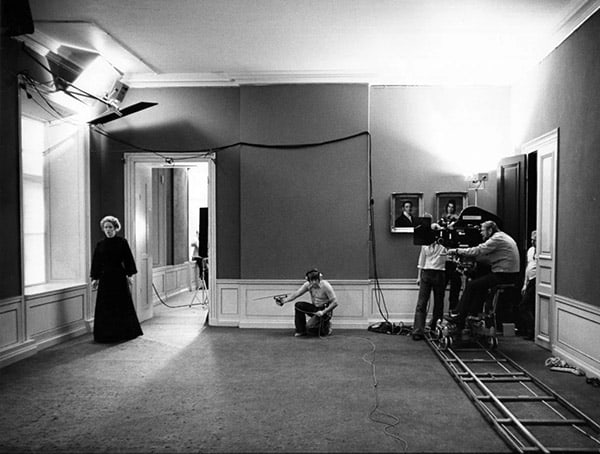
Have a Favorite Cinematography Quote?
Which quotes are your favorite? Do you know of any other cinematography quotes that may be helpful for our readers? Feel free to share in the comments section below.
If you’ve found the article helpful, then bookmark the page and return to it next time you’re in need of some inspiration from the masters of light.
Finally, don’t forget to share the article through your own blogs, forums and social media. The more links we have, the more time we can spend creating articles about master photographers and cinematographers.
Recommended Reading
American Cinematography (ASC)
British Cinematographer
Cinematography Books
Disclaimer: Photogpedia is an Amazon Associate and earns from qualifying purchases.
Masters of Light: Conversations with Contemporary Cinematographers
Reflections: Twenty-One Cinematographers at Work
Film Lighting: Talks with Hollywood’s Cinematographers and Gaffers
Painting With Light: John Alton
Related Quote Articles:
Quote Series: What Makes a Good Photograph?
Lessons from Master Painters
Quote Series: The Greatest Photography Quotes

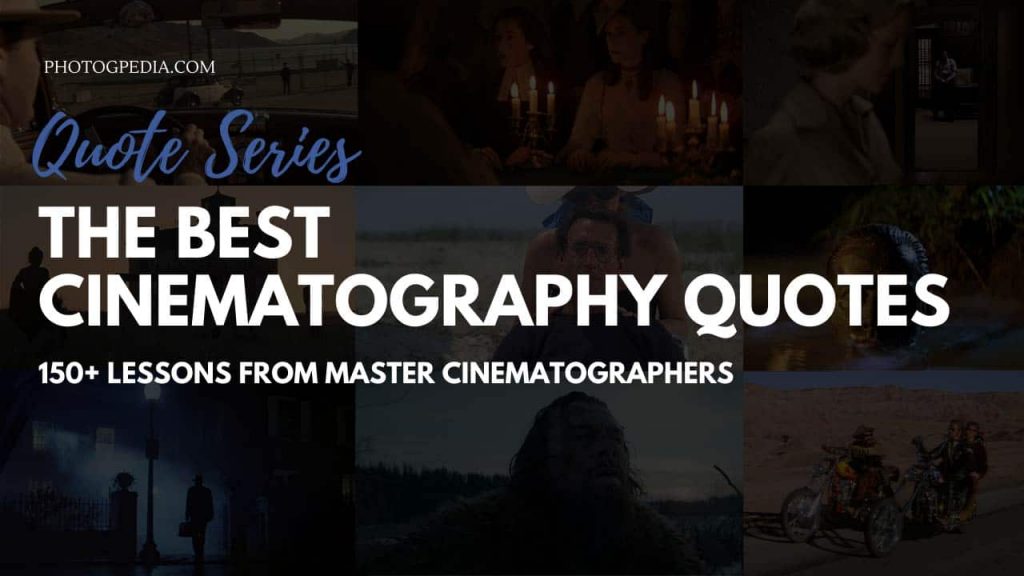
9 Comments
hey, where was the quote “Everything that is shadow, penumbra, and darkness suggests a dramatization of the subject” by Henri Alekan from, please?
Hi Steve
The quote is from the book Reflections: Twenty-One Cinematographers At Work by Benjamin Bergery (Chapter 11 – Beauty and the Beast, Page 86).
The book is well worth purchasing for the Alekan interview alone.
Thanks for stopping by. David
Thank you very much David
Hi,
May I ask where this quote is from?
“There’s always the intention to create visually stunning images, but ultimately, my greatest concern is to stay true to the drama of the scene”?
Thank you!
Hi Joana, the quote’s from the book Cinematography: Screencraft by Peter Ettedgui (Focal Press 1999). Highly recommended for any cinematographer.
Thank you!! I’ll give it a read.
I couldn’t find the origin of this one either:
“The biggest challenge of any cinematographer is making the imagery fit together of a piece: that the whole film has a unity to it, and actually, that a shot doesn’t stand out.”
Deakins
The Deakins quote is from an interview with Screencrush (the website). Roger Deakins on Sicario, September 2015. Thanks for visiting the website.
Hi David, from where this quote was taking please?
‘’ Sometimes I wish nobody would talk about how the movies are made.
The idea would be that the audience goes to the theatre and they don’t
even notice how it’s shot. I want the audience to just become immersed
in the movie and feel the anxiety that the character goes through while
his life implodes. That would be ideal.’’ by Emmanuel Lubezki
Hi, the Lubezki quote was taken from an interview with Definition Magazine from March 2015. Here’s the link: definitionmagazine.com/features/bird-men/